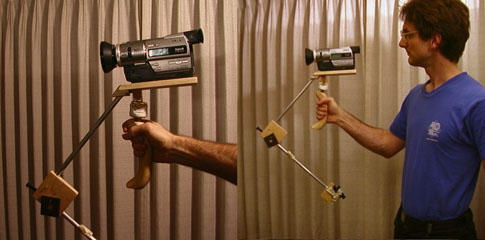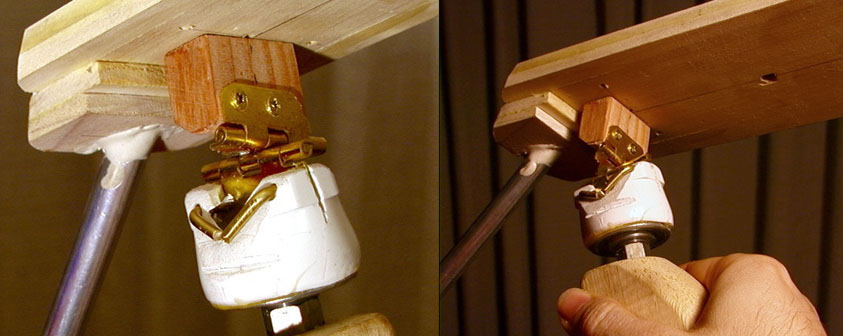

There are several commercial camcorder stabilizer options, which range from approximately $200 on up. You can also make one yourself for about $30 plus a weekend of work with some hand tools. It won't look as professional as the commercial products, but it works pretty well.
Other steady-cam pages: my design was inspired by Chris Santucci's XL1 stabilizer, although I did the pivot/gimble a bit differently. Steven-Marc Couchouron has another design at dvforever.com (in French, but the photos tell the story). You don't actually need a pivot: Gaby Kafka contributed a simpler design, see below, and the UVA Film Club has a simple, rugged design. To quote their page, "getting good results is not so much about the equipment but how you use it. That's really true about everything."
I describe my design on this page,
although it should be evident you could make different choices for
materials and methods and have a stabilizer that works just as well.
First, the parts needed (all from a hardware store):
Stabilizer Parts:1 ball-bearing, 1/2" I.D., 1 3/8" O.D. (sold by California Caster as a bearing for a wheel)
1 diameter reducer insert, 1/2" to 3/8" (also from California Caster)
1 3/8" diam. all-thread rod. (need only a 3" length)
1 1" male pipe adapter, PVC
1 wooden handle. (I used one intended for a cement trowel)
2 small brass hinges (similar to, but smaller than the one shown)
1/4" thick poplar
3/4" or 1" thick pine (not shown)
a small hardwood block (not shown)
1/2" aluminum tubing (not shown)
1/8" solid brass rod (not shown)

Also, you'll need:
hard solder (tin/silver), flux, propane torch (to join hinges)
drill, hacksaw, misc. handtools
wood glue, epoxy (joining wood, reinforcing Al tubing/wood joint)
The heart of this type of stabilizer is the pivot or gimble. I made
a gimble (pivots on two axes at once) using two hinges soldered together
at right angles. I hard-soldered the tab sections using silver-bearing
solder and a propane torch (careful not to get solder into the hinge joint
itself). You might be able to just bolt the hinges together, but the bolt
clearance may limit motion. The hinge body and center pin are just solid
brass, but I oiled the hinge joints and they move nicely. The top hinge
is screwed to a small hardwood block, in turn screwed to the underside
of the camera platform, and the bottom hinge is held in the PVC pipe fitting
as you see below.

The hinges allow the camera to pitch forward and back, and roll left and right. The ball-bearing allows rotation around a vertical axis. I cut about 3" of 3/8" all-thread rod and bored a hole in the top of the wood handle to receive this rod. The top of the rod has two nuts which capture the bearing, with the 3/8" reducer insert. I didn't need to use the washers shown in the parts photo. The wood handle is shortened and sanded down from the original shape.
Saw off the threaded part of the PVC fitting and put it in the oven at about 200 F to soften it. When it is slightly soft, press it over the bearing- it should fit tightly. (My fitting is deformed due to overheating- I practically melted it.)
When cool, use a hacksaw to cut a slot to receive the lower tab of the hinge, and also make diagonal slices off the top edge to allow the hinge assembly more freedom to tilt over left and right. Then, mount the bearing on the threaded rod and epoxy the PVC fitting on top of the bearing. I drilled two 1/8" holes in the fitting and used two bent lengths of 1/8" brass as retainer pins to hold the hinge assembly in place. This is just for ease of reconfiguration and disassembly; you could also use bolts, or epoxy. The 1/2" aluminum tube sections running forward and down from the camera platform terminate in wood blocks which were bored lengthwise with the 1/2" drill. The tube is held in the blocks with transverse 1/8" brass pins.
After assembling the stabilizer, you have to balance it by selective addition of weights. Fix the handle in a vise, place the camera on top, and start adding counterweights to the front and bottom blocks. You can see bolts and an iron washer taped to these blocks in my top photo. You can also move the camera back and forward for fine adjustment. Note that the LCD screen position, wide-angle lens attachment, and battery are all factors which affect balance point. Having achieved a good balance, mark the correct point and drill a 1/4" hole for the 1/4-20 bolt which matches the camera's tripod mounting socket. If you're going to use different batteries, lens adaptors, or cameras (!) you'll probably need to drill different holes, as well as adjust the counterbalance weights.
The bearing has more turning resistance than the hinges, but the final assembly has enough inertia that I get very smooth motion on all three axes. My two-hinge gimble design puts the forward-back pitch axis (upper hinge pin) about 3 mm above the side-to-side roll axis. You can actually feel this difference when balancing: when you add weight so that the overall center of mass coincides with the lower pivot, the stabilizer is neutral for side-to-side roll motion (you can tilt it to any angle and it stays there), but it still has a restoring force in the pitch direction (release it from off-vertical and it swings like a pendulum). If you make the pitch direction neutral, the roll axis is overbalanced and the camera will tend to roll over. In any case, I find the design is useful, and I was impressed by my test video walking around indoors- on playback, the camera really seems to be floating through the air.
By the way, you can use any materials you want. I just happened to use what I did because that's what the hardware store had. I did intentionally choose aluminum tubing because I wanted the whole thing to be as lightweight as possible, so I used a lightweight frame, and just added the minimum counterbalance weight necessary, exactly where needed.
There is something of an art to balancing this (or any other) stabilizer. You add weights to the front elbow and the bottom of the arm until the center of mass of the entire camera+platform+arm+weights is just a millimeter or so below the hinge pivot point, and centered on it so that the camera does not tend to rotate forward, back, or to the side. At that point, it will be just barely stable, almost wanting to tip over, but any hand motion will not much affect the aiming of the camera. You can "steer" the camera into a turn by swinging the bottom of the handle part left or right. If your camera rocks back and forth when you come to a stop, you probably have too much weight on the bottom; try removing some until the camera starts to tip over, then add a tiny bit back.
This stabilizer (and any other one) is best used with wide-angle shots only. I have used an external wide-angle adaptor. You will need to balance the assembly with the adaptor mounted, of course.
I wanted to share some info
with you and the people who visit your site concerning camera
stabilizers. I've been looking for very inexpensive ways to steady my
camera shot while walking, running or riding in a car. I do this
strictly for fun so I'm not about to spend a chunk of change on fancy
equipement. I've seen countless types of stabilizers and steady cams on
the market and I'm amazed at what people are asking for such equipement.
I'm an engineer and it's in my nature to analyze things to death so I
looked at the mechanics of what a stabilizing system does and by no
surprise all the manufacturers use the same principles (give or take a
few do-dads here and there). Without getting into too much detail I'll
just say that you can get awesome results with a simple monopod attached
to your camera. Attach your video camera to a monopod the same way as you
would a still camera. Hold the monopod in your hand and don't grip it too
tightly in the shaft but let the flange at the top of the shaft (where it
interfaces with your camera) rest on your fingers. Start recording and
start walking.
Like all other similar systems (Steady Tracker, Flight
Stick, etc) on the market your arm is what isolates vibration and the
weight attached to the camera is what tends to keep it stable (laws of
gravity). Obviously this is very simple and it's not 100% perfect due
to center of gravity variances in different cameras and the fact that
the system itself isn't perfectly balanced, but I'll bet I can get just
as good results using a $20 monopod (maybe with a little extra weight
duct taped to the end!!) as opposed to a $500 Steady Tracker or Flight
Stick. In fact I have! I've a attached a stupid little video
demonstrating the result using a monopod I picked up for $20. I used
nothing else. Just a monopod attached to my video camera. If you take a
look at Steady Tracker it's basically a fancy monopod with weight at the
bottom that you can adjust for center of gravity (hence there so called
new "CGX" balance technology - CGX stands for "center of
gravity..something...yeah,yeah.. whatever!!!!). Anyway I thought I would
send you this info and it might help your readers shoot better videos
for less $$$$.
A Very Simple Stabilizer
by Gaby Kafka Dec. 2000
Back to TRV900 page.